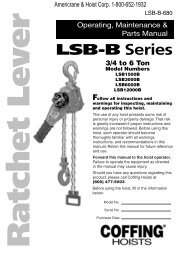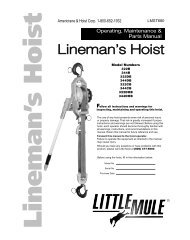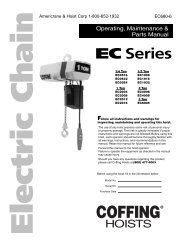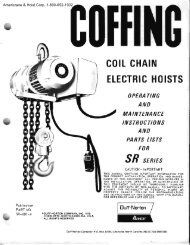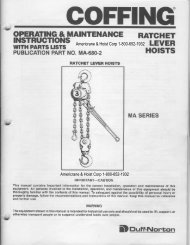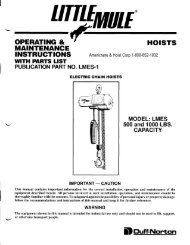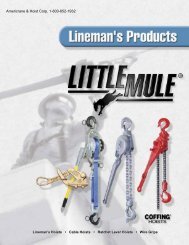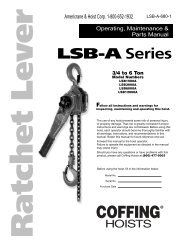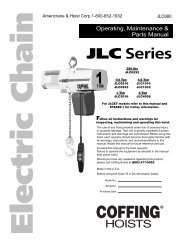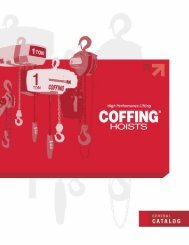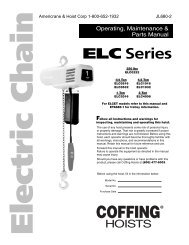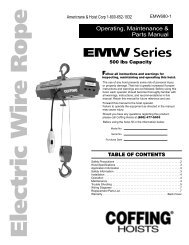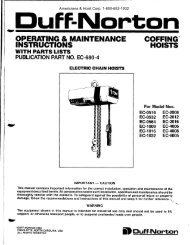ELCMT Series, JLMT 680-1 - Coffing Hoists, Coffing Hoist Parts
ELCMT Series, JLMT 680-1 - Coffing Hoists, Coffing Hoist Parts
ELCMT Series, JLMT 680-1 - Coffing Hoists, Coffing Hoist Parts
- No tags were found...
Create successful ePaper yourself
Turn your PDF publications into a flip-book with our unique Google optimized e-Paper software.
Country Club RoadP.O. Box 779Wadesboro, NC 28170 USATEL: (800) 477-5003FAX: (800) 374-6853CHECK BOTH UPPER AND LOWER LIMITS1. Connect the hoist to the power supply. Be sure the greenground wire is properly grounded (See ELECTRICALCONNECTIONS, page 6).2. Check load hook direction (See ELECTRICALCONNECTIONS 4, page 6).3. Carefully raise load block to upper limit and observe if itstops automatically at desired level. Do not allow load blockto run into hoist housing — this will damage the hoist.Maintain a minimum clearance of 2" from the hoist housingand the top of the load block on single-chained models and1" from the chain support to the top of the load block ondouble-chained models.4. Carefully lower load block to lower limit and observe if itstops automatically at the desired level. Do not allow slackchain, if attached to the dead-end screw, to become tautagainst hoist housing. This will damage the hoist. Thereshould be a minimum clearance of 1½" between the chainstop and the bottom of the hoist.5. If upper and lower limits operate satisfactorily, hoist is readyfor use. If they are not as desired, repeat adjustment.If the wires running to the limit switches are everdisconnected for any purpose, be sure to replacewires in accordance with the correct wiring diagram(See Figures 12A - 12F).HOIST BRAKEProperly adjusted, this brake will release promptly whenenergized. It is capable of both smoothly stopping and securelyholding the rated capacity of the hoist. If the hoist developseither undesirable over-travel after the pushbutton is released(this condition is most noticeable in the lowering direction) orhesitates to lift the load promptly when the pushbutton isdepressed (this condition is most noticeable in the hoistingdirection), the brake should be adjusted.BEGapAXDFigure 7 — Brake AssemblyFGXCAlways disconnect power source before working onor near a hoist or its connected load. If the powerdisconnect point is out of sight, lock it in the openposition and tag to prevent unexpected applicationof power.HBRAKE ADJUSTMENTRefer to Figure 7.1. DISCONNECT HOIST FROM POWER SUPPLY andremove the electrical cover.2. With reference to Figure 7, the gap between the brakearmature “A” and the field “B” should be checked. Thecorrect gap is 0.015". Adjustment should not be necessaryuntil gap reaches 0.040".Be sure the bottom of the armature does not bearagainst the splined adapter “H”. As adjustments aremade, the built-in clearance will be reduced. Whenthis clearance is gone REPLACE BRAKE DISCS.Minimum allowable disc thickness is .162".3. Adjust gap by adjusting the 3 locknuts “F” and checking witha feeler gauge to be sure gap is the same on both ends ofthe solenoid.4. Adjustment is now complete and the brake properly set.Replace the electrical cover, reconnect the power supply,and check hoist brake action.LUBRICATIONRefer to Figure 14.Proper lubrication is necessary for a long and relatively troublefreehoist operation. Refer to the following and Figure 14 forlubrication points, type of lubricant, and frequency oflubrication.Load ChainClean the load chain with acid-free solvent and coat with SAE90 gear oil. Wipe excess oil to prevent dripping. Never applygrease to the chain.GearingThe gear case of this hoist is filled at assembly withapproximately 1½ pints of SAE 90 EP gear oil. Check oil levelby removing the oil level check plug from the side of the hoist.With the hoist hanging level, gear oil should be even with thehole. Change oil periodically depending on the severity of theapplication and the environmental conditions (at least every200 hours of run time).BearingsAll bearings except hook and idler sheave bearings arelubricated at the factory and should not require additionallubrication. Noisy or worn bearings should be replaced.Limit Switch ShaftRemove any dirt accumulation and spray with a generalpurpose lubricant.Hook BearingApply a few drops of SAE 30 gear oil around the edge of thebearing.Idler Sheave Bearing (Bushing) - 2 Ton ModelsDisassemble load block and apply a light coat of NLGI #2grease, or equivalent, inside of bearing.11



